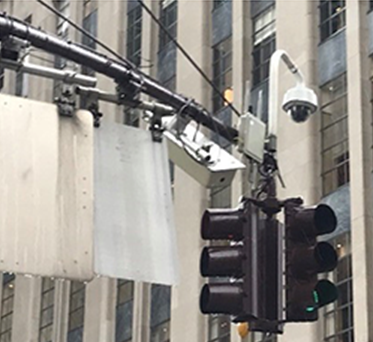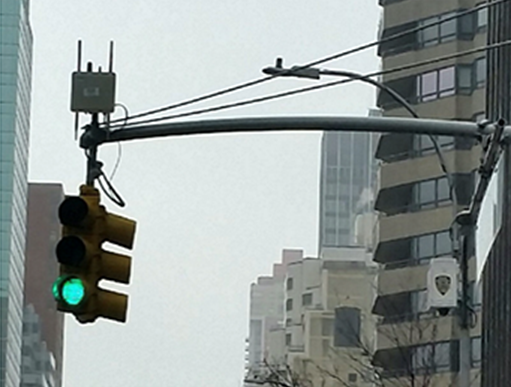After trying several variations, NYCDOT finds optimal vertical mounting approach for installing roadside units (RSUs) at signalized intersections.
NYCDOT develops an installation method for roadside units (RSUs) that reduces the potential for antenna damage, improves line of sight, and reduces the time installation crews need to be in the air.
New York City, New York, United States
New York City Connected Vehicle Pilot Optimizes RSU Installation Practices
Summary Information
Device installation is a key stage of the Connected Vehicle (CV) Pilots as Vehicle-to-Vehicle (V2V) and Vehicle-to-Infrastructure (V2I) technologies are deployed into the field in large quantities. The CV Pilot teams are working hard to ensure efficient, reliable, and quality installations, while documenting lessons learned from the process for future deployers of CV technology.
One of the lessons learned from the New York City Department of Transportation (NYCDOT) CV Pilot relates to the installation of the 450 roadside units (RSUs) NYCDOT had to install at signalized intersections. While preparing the installations, preliminary site inspections were performed to select mast arm locations for the RSUs. These sites typically extended into the intersections to provide line-of-sight for approaches from every direction without altering the intersection’s existing poles, mast arms, and cabinet locations.
The initial installation method was to fasten RSUs directly to the mast arms approximately 18 inches from the signal head hanger. However, shortly after the prototype unit installations were complete, high winds occurred that caused a signal head to swing far enough to break an RSU antenna. This triggered a quest for an alternative installation method that could withstand high winds.
After several experiments, the team selected a vertically mounted extension that provided several advantages. In addition to reducing the potential for antenna damage, the key advantage was that the RSU and mounting devices were preassembled, reducing the time installation crews needed to be in the air to attach equipment to the mast arm. Secondly, the equipment cabling reduced the necessary overhead work yet provided the same benefits.
Equipment grounding is critical to the installation of the equipment and was easier to maintain with the revised mounting arrangement. Finally, the additional height improved line-of-sight and reduced the impacts of other devices mounted on the mast arm. The revised installation method has been a big win for the maintenance crews.

|

|
